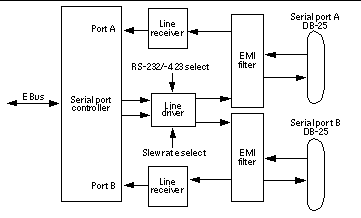C.1.9 Serial Port
The system unit incorporates two serial ports. Each serial port is synchronous and asynchronous with full modem controls. All serial port functions are controlled by a serial port controller that is electrically connected to the system through the EBus. Line drivers and line receivers control the serial port signal levels and provide RS-232 and RS-423 compatibility. Each serial port interfaces through its own DB-25 connector.
The major features of each serial port include:
-
Two fully functional synchronous and asynchronous serial ports
-
DB-25 connectors
-
Increased baud rate speed (to 384 Kbaud, synchronous; 460.8 Kbaud, asynchronous)
-
Variable edge rate for greater performance
-
EBus interface
C.1.9.1 Serial Port Components
Serial port components include a serial port controller, line drivers, and the line receivers.
The serial port controller contains 64-byte buffers on both the input and output. This enables the serial port to require less CPU bandwidth. Interrupts are generated when the buffer reaches 32 bytes or half full. The serial port controller contains its own crystal oscillator that supports rates of up to 921.6 Kbaud.
The line drivers and line receivers are compatible with both RS-232 and RS-423. Two system board jumpers are used to set the line drivers and line receivers to either RS-232 or RS-423 protocols. The line driver slew rate is also programmable. For baud rates over 100K, the slew rate is set to 10 VDC/msec. For baud rates under 100K, the slew rate is set to 5 VDC/msec.

Serial Port Functions
The serial port provides a variety of functions. Modem connection to the serial port allows access to the internet. Synchronous X.25 modems are used for telecommunications in Europe. An ASCII text window is accessible through the serial port on non-graphic systems. Low-speed printers, button boxes (for CAD/CAM applications) and exotic devices that function like a mouse are also accessible through the serial port. The additional speed of the serial port can be used to execute communications with a CSU/DSU for a partial T1 line to the internet at 384 Kbaud per second.
EIA Levels
Each serial port supports both RS-232 and RS-423 protocols. RS-232 signaling levels are between -3 VDC and -15 VDC and +3 VDC and +15 VDC. A binary 1 (0012) is anything greater than +3 VDC and a binary 0 (0002) is anything less than -3 VDC. The signal is undefined in the transition area between -3 VDC and +3 VDC. The line driver switches at -10 VDC and +10 VDC with a maximum of -12 VDC and +12 VDC in RS-232 mode. RS-423 is similar except that signaling levels are between -4 VDC to -6 VDC and +4 VDC and +6 VDC. The line driver switches at -5.3 VDC and +5.3 VDC with a maximum of -6 V and +6 VDC. Switching from RS-232 to RS-423 protocol is accomplished by changing jumpers J2604 and J2605. Jumper positions 1 and 2 are for RS-232 and jumper positions 2 and 3 are for RS-423.
The preferred signaling protocol is RS-423. The higher voltages of R-232 make it difficult to switch at the higher baud rates. The maximum rate for RS-232 is approximately 64 Kbaud while the maximum rate for RS-423 is 460.8 Kbaud. The system default is set to RS-232.
Synchronous Rates
The serial synchronous ports operate at any rate from 50 Kbaud to 256 Kbaud when the clock is generated from the serial port controller. When the clock is generated from an external source, the synchronous ports operate at up to 384 Kbaud. Clock generation is accurate within 1 percent for any rate that is generated between 50 Kbaud and 256 Kbaud.
Asynchronous Rates
The serial asynchronous ports support twenty baud rates that are all exact divisors of the crystal frequency (with exception for 110, which is off by less than 1 percent). Baud rates include 50, 75, 110, 200, 300, 600, 1200, 1800, 2400, 4800, 9600, 19200, 38400, 57600, 76800, 115200, 153600, 230400, 307200, and 460800.
Slew Rate and Cable Length
The maximum RS-423 cable length is 118 feet (30 meters) and the maximum RS-232 cable length is 50 feet (15.24 meters). The slew rate changes depending on the speed. For speeds less than 100 Kbaud, the slew rate is set at 5 VDC per microsecond. For rates greater than 100 Kbaud, the slew rate is increased to 10 VDC per microsecond. This allows maximum performance for the greater baud rates and better signal quality at the lesser baud rates.
- © 2010, Oracle Corporation and/or its affiliates
